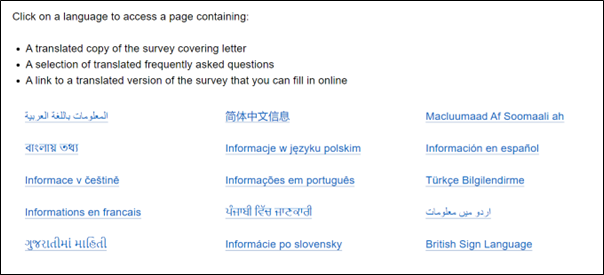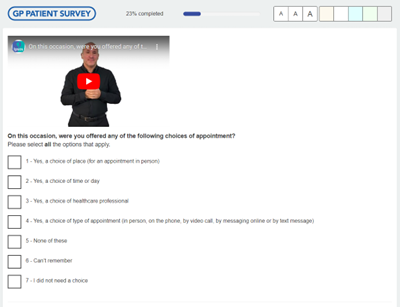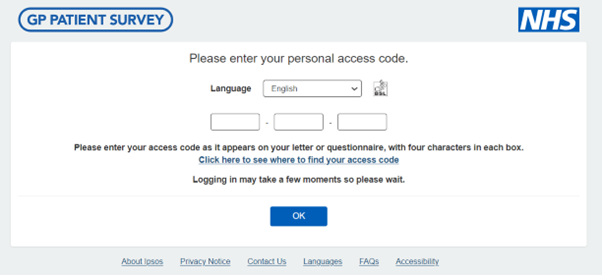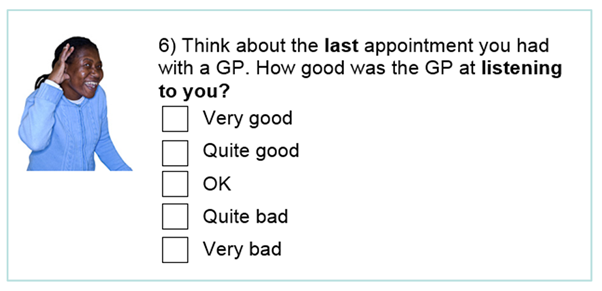The GP Patient Survey (GPPS) is designed to give patients the opportunity to feed back about their experiences of their GP practice. The survey has been running for eighteen years; it is commissioned by NHS England and carried out by Ipsos.
GPPS is a postal push-to-web survey, with paper and online options for taking part. In January 2024, questionnaires were sent to around 2.5 million patients aged 16 or over, using a combination of postal and text message reminders to encourage people to take part.
To ensure the survey is inclusive, and ultimately to improve representativeness, it is important that everyone who is invited can take part. However, the scale of GPPS and the push-to-web methodology mean that ensuring it is fully accessible is challenging. For example, it is not possible to identify what support people may need in advance of fieldwork as we do not have access to this information from patient records, and it is not feasible to send accessible versions of the survey to everyone.
Despite these constraints we plan with inclusivity in mind. In this blog, we describe some of the practical lessons we have learnt while delivering GPPS that may help to improve inclusivity on other push-to-web surveys.
For example, we offer a wide range of accessible options, considering the following principles:
- use language that is easy to understand, with letters and the questionnaire reviewed by the Plain English Campaign.
- provide information about the survey and the privacy policy in an easy read format.
- ensure the online survey platform is compatible with screen readers, allows keyboard navigation and includes options to adjust the colour contrast and increase the font size.
- translate the online survey, invitation letter and key frequently asked questions (FAQs) into British Sign Language and 14 other languages.
- give participants the option to complete the survey over the telephone via our helpline team.
- offer the survey in large print and Braille formats on request.
- make a Text Relay service available.
- ensure the website follows good practice in terms of accessibility features, with a published accessibility statement.
Below we look at some of these features in more detail.
Other languages and BSL
The online survey, invitation letter and FAQs (which includes the privacy policy) are all available on the GP Patient Survey website in 14 languages, in addition to English. Participants are also able to complete the survey over the phone in any of these 14 languages. This can be requested using language specific voicemails, which are signposted on the invitation letters and via the GPPS website. During fieldwork in 2023, 6,199 people took part online in another language (1.8% of all online responses) and 672 people were supported to take part on the telephone, including 26 people who completed the survey by telephone with an interpreter.
Figure 1: Signposting to additional languages on the GPPS website

For British Sign Language (BSL) users, there is a
dedicated webpage, with video clips of answers to some FAQs. We also provide a BSL version of the online survey, which has video clips for each question and the available response options embedded. In 2021, to improve the experience for BSL users, in collaboration with our BSL supplier Remark!, we numbered the response options on the online survey and included the numbering in the signed videos, to better support people in selecting their answers. Overall in 2023, 196 people took part online using the BSL option.
Figure 2: BSL online survey

To improve signposting to the translations, in 2017, the online survey login page was reprogrammed to include a language drop down. This was a very simple change which made it easier to access the other language versions, resulting in a doubling of the number using the translations (819 in 2016 and 1,767 in 2017). In 2021, we also added a BSL logo to the online survey login page, which resulted in a doubling of the number of people using the BSL version. While these remain a small proportion of those taking part in GPPS overall, they play an important role in including traditionally underrepresented voices in our research.
Figure 3: GPPS online survey login page

Easy read questionnaire
Providing a questionnaire in an easy read format can help a range of people who would otherwise struggle to complete a survey even with assistance, including those with a learning disability, low literacy or whose first language is not English. However, recent evidence suggests that easy read materials are not always effective and still favour more able individuals and, as we found, they are difficult to administer on postal surveys like GPPS.
In 2017, we developed an easy read version of the GPPS questionnaire. This was a shortened version of the main questionnaire (28 questions instead of 62) and was developed in collaboration with Mencap. It was signposted to patients on the reverse of the invitation letter using text and an easy read logo. The questionnaire could be requested either through calling or emailing the helpline team. However, uptake was low, with just three easy read requests and two returns. This is likely to have been a result of a combination of factors, including the fact that the easy read logo was not widely recognised and, even where it was, the cognitive effort required to contact the helpline to request the questionnaire in this format was significant. Many other surveys that provide easy read formats are able to identify those who need them in advance, and this is not possible on GPPS.
Figure 4: 2017 GPPS easy read questionnaire

As a result, we do not currently offer an easy read version of the questionnaire, however we do provide an easy read information sheet and an easy read privacy policy on the GPPS website, alongside other support to take part. While the proportion of those taking part reporting they have a learning disability is similar to other population measures (3% GPPS and 3% adults 18+ in England), we keep this under continual review, for example, based on learnings from other surveys, such as the Adult Social Care Survey.
The GPPS website
Since 2018, all public sector organisations have been required to meet the global Web Content Accessibility Guidelines (WCAG 2.1) for online content. This applies to websites, and everything uploaded onto them.
To meet these standards, following an independent accessibility audit, we have made several changes to the website. The more significant changes included updating the website to ensure:
- It is fully compatible with a range of screen reader software.
- It can be navigated with a keyboard (where possible).
- The colours used on the website meet colour contrast standards.
- Ability to zoom in up to 300% with text staying visible on the screen, and most images scaling without resolution loss.
We also have a website accessibility statement, which is regularly reviewed.
In summary, GPPS strives to gather inclusive patient feedback and offers various accessible options. While we have faced challenges in ensuring the right accessible formats are provided and signposted, continuous improvements are made to enhance accessibility and ensure valuable insights are gained from patients across England.
Next steps
GPPS offers a unique opportunity to understand the experience of health inequalities and it is important to ensure all patients can take part if they wish and are not met with barriers. While we have shared some examples from GPPS to date, we know that more can be done and must continually review our understanding of barriers to taking part. This may include better signposting or co-production with underrepresented groups.
We would also be keen to hear from others who can share transferable lessons from tackling similar issues across the full range of survey methodologies and topics.
AUTHOR BIOS: Amun is a senior research executive in the Public Affairs team at Ipsos. She has been involved in both quantitative and qualitative research projects for a range of public sector clients with a particular focus on health.
Rachel has over 25 years of experience in social research, designing, directing and delivering research projects. She specialises in delivering large quantitative surveys with complex elements. Rachel currently leads on the GP Patient Survey for Ipsos, providing overall direction for the study.